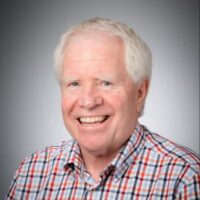Expertise
Areas of Specialization
-
Professor Emeritus
Chemical Engineering
-
Director
Chemical Engineering
Overview
Research Interests
Fluid Mechanics and Heat Transfer
The main focus of my work is fluid mechanics and heat transfer with particular emphasis on mixing problems. The projects have both theoretical and experimental components.
1. Static Mixers and Twin Screw Extruders
In this project we propose to study mixing in a Kenics type static mixer and the intermeshing twin screw extruder. A Kenics static mixer is a series alternating right handed or left handed twisted tapes or elements. In the standard design each element twists through 180 degrees and each successive element is off-set by 90 degrees. As the fluids to be mixed pass through the mixer they are periodically separated and rotated, reducing the scale of segregation or “striation thickness” with each successive element. The objectives of this research will be to: (1) create a data base of velocity measurements (axial, radial and tangential) in a static mixer as a function of aspect ratio, Reynolds number and flow rate ratio, (2) develop a visual technique for measuring striation thickness in a Kenics static mixer, (3) develop a measure of mixing that can be used to characterize the degree of mixedness in a static mixer, and (4) use computational fluid dynamics to compute the velocity field for comparison with the measured velocities.
2. Mixed Convection Heat Transfer
Mixed convection flow and heat transfer occur frequently in engineering and natural situations. One important application occurs when a heated surface is cooled by a flowing fluid where the flow may be in the direction of, or opposed to, the gravity vector. In this research project we propose to carry out a fundamental experimental and computational study of mixed convective flow. The objectives of the study will be to: (1) create a data base of velocity and temperature measurements in a well characterized geometry ( a heated wall cavity), (2) apply the PIV technique to these flows and validate its use by comparison to other experimental measurements, (3) develop a low Reynolds number turbulence model which accounts for the inherent anisotropy of the turbulence, and (4) to develop a new numerical solution algorithm which allows for a closer coupling between the temperature and velocity fields than the presently used SIMPLE based methods.
3. Suspension Polymerization
In suspension polymerization liquid monomer droplets are dispersed in water. During the period of the polymerization the droplets become solid. The droplets are maintained in suspension and coalescence is prevented by the combined action of mixing and surface active agents. These will also affect the particle size distribution (PSD). The ability topredict and control the PSD is of considerable importance to the polymer industry. The principal goal of this research will be to develop a mathematical model for the estimation and design of the polymer PSD obtained in suspension copolymerization.
- B.A.Sc., University of Waterloo (1973)
- Ph.D. California Institute of Technology (1978)
- F.C.I.C., P.Eng., 3M Teaching Fellow, HEQCO Fellow
Vivaldo Lima, E., A.E. Hamielec and P.E. Wood, “Auto Acceleration Effect in Free Radical Polymerization. A Comparison of the CCS and the MH Models”, Polymer Reaction Engineering, 2, 17-86, (1994).
Nurnberg, G., P.E. Wood and M. Shoukri, “Experimental and Numerical Turbulent Bouyant Flow in an Enclosure”‘, 10th Int. Heat Transfer Conf., England, 7, 119-124, (1994).
Kresta, S.M. and P.E. Wood, “The Flow Field Produced by a 45ø Pitched Blade Turbine: Characterization of the Turbulence and Estimation of the Dissipation Rate”, Chem. Eng.Sci., 48, 1761-1774, (1993).
Wood, P.E., A.N. Hrymak, R.W. Yeo, D.A. Johnson, and A. Tyagi, “Experimental and Computational Studies of the Fluid Mechanics in an Opposed Jet Mixing Head”, Physics of Fluids A, 3, 1362-1368, (1991).


